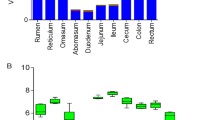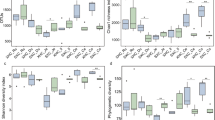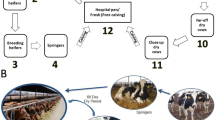Abstract
To determine the effect of monensin, a carboxylic polyether ionophore antibiotic, on the bacterial population structure of dairy cattle colonic contents, we fed six lactating Holstein cows a diet containing monensin (600 mg day−1) or an identical diet without monensin. Fresh waste samples were taken directly from the animals once a month for 3 months and assayed for their bacterial population structure via 16S rRNA gene sequence analysis. In total 6,912 16S rRNA genes were examined, comprising 345 and 315 operational taxonomic units (OTUs) from the monensin fed and control animals, respectively. Coverage estimates of the OTUs identified were 87.6% for the monensin fed and 88.3% for the control colonic content derived library. Despite this high level of coverage, no significant difference was found between the libraries down to the genus level. Thus we concluded that although monensin is believed to increase milk production in dairy cattle by altering the bacterial population structure within the bovine gastrointestinal tract, we were unable to identify any significant difference in the bacterial population structure of the colonic contents of monensin fed vs. the control dairy cattle, down to the genus level.

Similar content being viewed by others
References
Agricultural Statistics Board (2007) Agricultural Statistics, 2007. National Agricultural Statistics Service. http://usda.mannlib.cornell.edu/usda/current/MilkProd/MilkProd-10-17-2008.pdf. Accessed 28 November 2008
Chen G, Russell JB (1989) More monensin sensitive, ammonia-producing bacteria from the rumen. Appl Environ Microbial 55:1052–1057
Chow JM, Russell B (1990) Effect of ionophores and pH on growth of Streptococcus bovis in batch and continuous culture. Appl Environ Microbiol 56:1588–1593
Chow JM, Van Kessell JA, Russell JB (1994) Binding of radiolabeled monensin and lasalocid to ruminal microorganisms and feed. J Anim Sci 72:1630–1635
Duffield TF, Bagg RN (2000) Use of ionophores in lactating dairy cattle: a review. Can Vet J 41:288–372
Duffield TF, Sandals D, Leslie KE, Lissemonre K, McBride BW, Lumsden JH, Dick P, Bagg R (1999) Effect of prepartum administration of a monensin controlled release capsule on milk production and milk components in early lactation. J Dairy Sci 82:272–279
Gallardo MR, Castillo AR, Bargo F, Abdala AA, Maciel MG, Perez-Monti H, Castro HC, Castelli ME (2005) Monensin for lactating dairy cows grazing mixed-alfalfa pasture and supplemented with partial mixed ration. J Dairy Sci 88:644–652
Good IJ (1953) The population frequencies of species and the estimation of population parameters. Biometrika 40:237–262
Green HB, Symanowski JT, Wagner JR, Wilkinson JID, McCleary DG (1999) Effect of monsin on milk production parameters, feed intake, body weight, body condition, and efficiency of milk production when fed to Holsteins. Bovine Proc 32:236–237
Haney ME Jr, Hoehn MM (1968) Monensin, a new biologically active compound. I. Discovery and isolation. Antimicrobial Agents and Chemother 7:349–352
Hayes DP, Pfeiffer DU, Williamson NB (1996) Effect of intraruminal monensin capsules on reproductive performance and milk production of dairy cows fed pasture. J Dairy Sci 79:1000–1008
Heck KL Jr, Van Belle G, Simberloff D (1975) Explicit calculation of the rarefaction diversity measurement and the determination of sufficient sample size. Ecology 56:1459–1461
Holland S (1998) aRarefactWin. University of Georgia, Athens
Hurlbert SH (1971) The nonconcept of species diversity: a critique and alternative parameters. Ecology 52:577–586
Johnson JC, Utley PR, Mullinix BG, Merrill A (1988) Effects of adding fat and lasalocid to diets of dairy cows. J Dairy Sci 71:2151–2165
Klappenback JA, Saxman PR, Cole JR, Schmidt TM (2001) rrndb: the ribosomal RNA operon copy number database. Nucl Acids Res 29:181–184
Lane DJ (1991) 16S/23 S rRNA sequencing. In: Stakebrandt E, Goodfellow M (eds) Nucleic acid sequencing techniques in bacterial systematics. Wiley, New York, pp 115–175
McGarvey JA, Miller WG, Zhang R, Ma Y, Mitloehner F (2007) Bacterial population dynamics in dairy waste during aerobic and anaerobic treatment and subsequent storage. Appl Environ Microbiol 73:193–202
Polz MF, Cavanaugh CM (1998) Bias in template to product ratios in multitemplate PCR. Appl Environ Microbiol 64:3724–3730
Richerdson LF, Raun AP, Potter EL, Cooley CO, Rathmacher RP (1976) Effects of monensin on rumen fermentation in vitro and in vivo. J Anim Sci 43:657–664
Russell JB (1987) A proposed model for monensin action in inhibiting rumen bacterial growth: effects on ion flux and protonmotive force. J Anim Sci 67:1519–1525
Russell JB, Martin SA (1984) Effects of various methane inhibitors on the fermentation of amino acids by mixed rumen microorganisms in vitro. J Animal Sci 59:1329–1338
Russell JB, Strobel HJ (1989) Effect of ionophores on ruminal fermentation. Appl Environ Microbiol 55:1–6
Russell JB, Houlihan A (2003) Ionophore resistance of ruminal bacteria and its potential impact on human health. FEMS Microbiol Rev 27:65–74
Sauer FD, Kramer JKG, Cantwell WJ (1989) Antiketogenic effects of monensin in early lactation. J Dairy Sci 72:436–442
Sauer FD, Fellner V, Kinsman R, Kramer JK, Jackson HA, Lee AJ, Chen S (1998) Methane output and lactation response in Holstein cattle with monensin or unsaturated fat added to the diet. J Anim Sci 76:906–914
Van der Werf JHJ, Jonker LJ, Oldenbroek JK (1998) Effect of monensin on milk production by Holstein and Jersey cows. J Dairy Sci 81:427–433
Wang QG, Garrity M, Tiedje JM, Cole JR (2007) Naive Bayesian classifier for rapid assignment of rRNA sequences into the new bacterial taxonomy. Appl Environ Microbiol 73:5261–5267
Weimer PJ, Stevenson DM, Mertens DR, Thomas E (2008) Effect of monensin feeding and withdrawal on populations of individual bacterial species in the rumen of lactating dairy cows fed high-starch rations. Appl Microbiol Biotechnol 80:135–145
Westley JW, Oliveto EP, Berger J, Evans RH Jr, Glass R, Stempel A, Toome V, Williams T (1973) Chemical transformations of antibiotic X-537A and their effect on antibacterial activity. J Med Chem 16:397–403
Acknowledgments
The authors wish to thank Mr. Jeremy Lathrop for his assistance with 16S rRNA gene library construction and sequencing. This work was funded by the USDA, ARS.
Author information
Authors and Affiliations
Corresponding author
Rights and permissions
About this article
Cite this article
McGarvey, J.A., Hamilton, S.W., DePeters, E.J. et al. Effect of dietary monensin on the bacterial population structure of dairy cattle colonic contents. Appl Microbiol Biotechnol 85, 1947–1952 (2010). https://doi.org/10.1007/s00253-009-2229-8
Received:
Revised:
Accepted:
Published:
Issue Date:
DOI: https://doi.org/10.1007/s00253-009-2229-8




